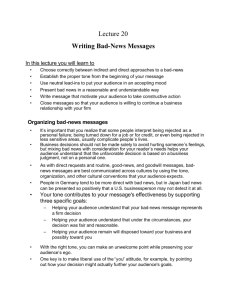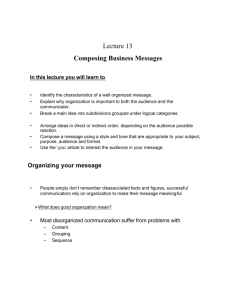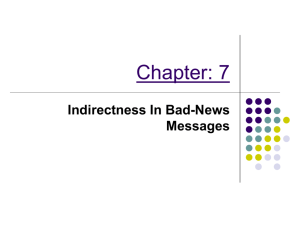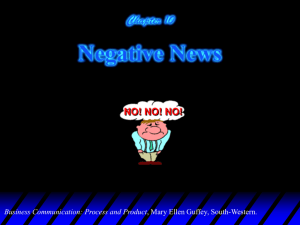Negative or “Bad News” Messages
advertisement
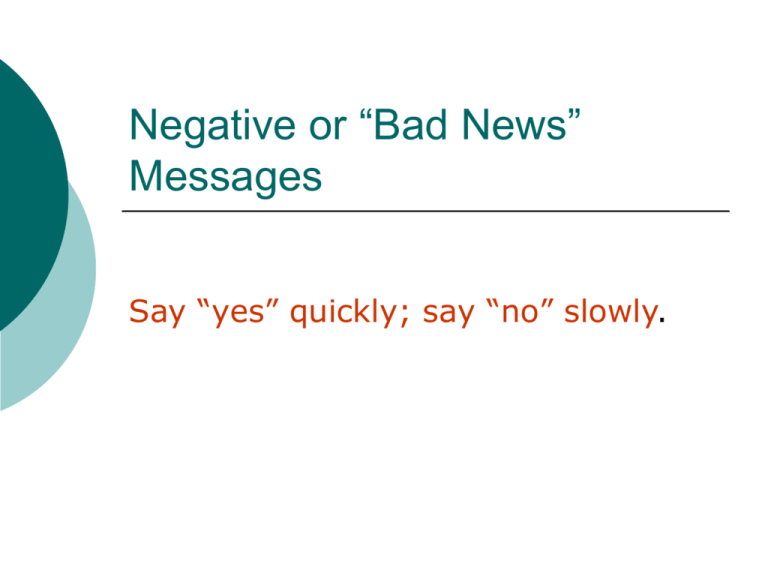
Negative or “Bad News” Messages Say “yes” quickly; say “no” slowly. Types of negative messages Request refusal News that is disappointing to reader Job changes Economic news Policy changes Writing Bad-News Messages The Three-Step Process Planning Writing Audience Completing Message Message Audience Strategies for Bad-News Messages Convey the message Gain acceptance Maintain goodwill Promote a good corporate image Minimize future correspondence Audience-Centered Tone The “You” Attitude Positive Wording Respectful Language The Indirect Approach Flow of the Message Buffer Reasons Bad News Positive Close Step 1 Step 2 Step 3 Step 4 Substance of the Message Begin With a Buffer Things to Do Things to Avoid Show appreciation Saying “no” Pay attention A know-it-all tone Compliment reader Wordy phrases Be understanding Apologies Show sincerity Lengthy buffers Follow With Reasons Cover positive points Provide relevant details Highlight benefits Minimize company policy Avoid apologizing State the Message De-emphasize the Bad News Use a Conditional Statement Focus on the Positive Avoid Blunt Language Close With Confidence Remain Positive and Sincere Limit Future Correspondence Stay Confident and Optimistic Cultural Differences Proper Tone Message Organization Cultural Conventions High Context Cultures Meaning conveyed through nonverbal actions and environmental setting Uses indirectness to avoid conflict Relationships must be built before business can be transacted Claims and Adjustments Things to Employ Things to Avoid Courtesy and Tact Accepting Blame Indirect Approach Accusations Understanding and Respect Negative Language Positive Attitude Defamation Organizational News Products Operations Match your approach to the situation Give accurate messages to dispel rumors Give reasons and any positive points Show actions are necessary and reasonable Plan the sequence of multiple announcements Tell those most affected first Minimize the element of surprise Crisis Management Plan Have a notification plan Have alternate communication channels Set up a central location for information and questions Letters of Recommendation Requested by Businesses Be Direct State Facts Requested by Individuals Practice Diplomacy Recognize Feelings Employment Applications Use a Direct Approach State Reasons Clearly Suggest Alternatives Performance Reviews Review Job Requirements Provide Feedback Develop a Plan of Action Negative Performance Reviews Confront the problem Plan the message Respect privacy Focus on the problem Obtain commitment Giving Constructive Criticism 1. 2. 3. 4. Make sure the person is prepared to hear the criticism. Carefully and clearly describe their behavior. Use the “Oreo” effect whenever possible. Be as specific as possible. Giving Constructive Criticism 5. 6. 7. Restrict criticism to recent behavior. Direct criticism to behavior the person can do some thing about. If possible, include suggestions for improvement. Termination Letters Express the Decision Give Specific Justification Minimize Negative Feelings Refusing Requests Example We regret to inform you that we cannot grant your request for a donation… Your efforts to build scholarship fund…are most commendable. So many requests are made of us that we have found it necessary to budget a set amount for this purpose. Our budgeted funds for this year are exhausted, so we cannot consider any more request. We will be able to consider your request next year. We are always willing to assist worthy causes when we can. Each January we budget for the year the maximum amount we feel we can contribute to such causes. Since our budgeted contributions for this year have already been made, we have placed your organization on our list for consideration next year. We deeply regret our inability to help you now and trust that you understand our position. We wish you the best of luck in your efforts to help educate the deserving children of the association’s members. Direct or Indirect? A memo to your boss informing her that one of your key clients is taking its business to a different accounting firm. Direct Direct or Indirect? A letter to a customer explaining that the tape backup unit he ordered for his new customer computer is on back order and that, as a consequence, shipping of the entire order will be delayed. Indirect Direct or Indirect A letter from a travel agent to a customer stating that the airline will not refund her money for the flight she missed but that her tickets are valid for one year. Indirect De-emphasize Negative The airline can’t refund your money. The “Conditions” segment on the back of your ticket states that there are no refunds on missed flights. Sometimes the airline makes exceptions, but only when life and death are involved. Of course, your ticket is still valid and can be used on a flight to the same destination. Even though unused tickets are nonrefundable, your ticket is still valid and may be used to travel to the same destination within one year from the original ticket date. Use a Buffer? You have to tell a restaurant owner that your plans have changed and that you have to cancel the 90person banquet scheduled for next month. Editing Your Work First Reading – check material Sufficient examples Clear interpretation Quality sources Sound reasoning Adequate but concise coverage Purpose fulfilled Second Reading – check organization Subject stated clearly Advanced in clear, logical stages Connections between stages clear Smooth transitions Third Reading – mechanics Sentences are clear, correct, concise Words are specific and concrete Spelling, punctuation, typography correct and consistent

